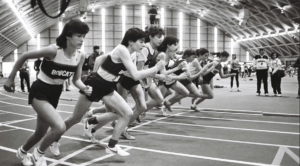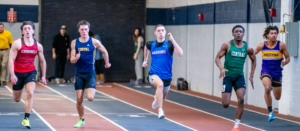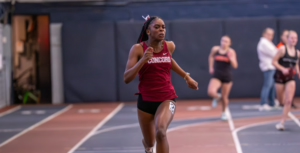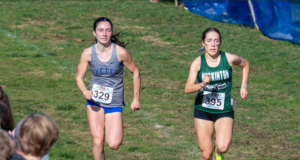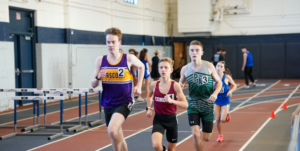2013
Installment 1
Now that I don’t have to copy, collate, fold, stuff, seal and stamp 150 newsletters each week, I plan to use my “corner” to share info and stories with you. If you have questions that you want me to try and answer, feel free to e-mail me at lemnhxc@aol.com.
I am often asked which training plan I think is best for high school athletes. Having been involved with cross country as both an athlete and a coach for over 50 years, I have seen that everything can be successful—from mega-miles plans, to plans that entail lots of speed work. What I have learned, I think, from this is that any plan can be successful as long as 1) you and your athletes believe in it, 2) it is followed consistently, and , most importantly, 3) you don’t over-do-it- i.e. you don’t hurt your athletes. During the 1970’s and 1980’s I was a moderately successful NH high school coach—winning class titles in all three classes—M&S, I, and L while at Raymond and Londonderry. Does anyone know of anyone else who has done that? While winning those titles, another goal was also to make it to the New Englands, which I did on many occasions. However, once we made the New Englands, my teams never seemed to perform well in them, as we usually finished in the bottom half. In the late 1980’s and early 1990’s I discovered something that really changed how I thought about coaching and that made me a much better coach. How much better? Well, from 1994 to 2004, a period of 11 years, my teams finished second three times and first three times in the New Englands. This happened as my athletes actually did less than they had in the 1970’s and 1980’s. In a week or two, I will share with you how I became a much better coach.
Installment 2
My progression to become a better coach started in 1985, when the Oyster River Middle School won its 1st Middle School Girls State Championship by 5 points over Hood of Derry. The Bobcats were led by 8th grader Amy Martin, now Amy Sanborn, my daughter. That same Fall, Joyce Anderson of Oyster River won the Class I individual title. However, Oyster River did not have a girl’s team—Joyce ran with the boys. That was about to change as all of the middle school’s top girls were 8th graders. As a concerned parent, I approached the OR administration and suggested that they had better institute a girls team in 1986 or a group of parents were going to have Title 9 issues. I also informed them that I had a friend who would like to coach them! That friend was Jeff Johnson—one of the original founders of Nike. Jeff was well known in the NH coaching circles as he coached Exeter’s girls when girls cross country first began in 1975. In that first year, when one girl’s race was run, Exeter easily won, and then proceeded to win Class I in 1976, 1977, and 1978. He then had to leave coaching for business concerns, but returned in the middle 80’s to “retire” to his Pawtuckaway lakeside home. Jeff was hired as the OR girls’ coach for $1.00 and quickly proceeded to build outstanding cross country and track programs. In their first season of cross country, the Bobcats won the Class I title and repeated in 1987 and 1989. Amazingly, in 1989, this same group of girls, representing a school of just over 500 students that didn’t even have a team four years earlier, scored an over 50 point victory in capturing the New England Championship. As a parent—not a coach—I had the pleasure of watching Amy enjoy much success as she developed into the team leader, and as Jeff would say, “team mother.”
After high school, Amy’s success continued as she decided to go to college at Cortland, NY State, whose woman’s team was coached by Jeff’s friend, and coaching mentor, Dr. Jack Daniels. In her four years at Cortland, Amy was a part of three Division III NCAA championship teams, plus one runner-up. Again, as parents, Marguerite and I flew all over the country to watch.
But going back to how I started this article—how did this make me a better coach—so much so that my boys teams were 1st or 2nd in the NE’s 6 times in a period of 10 years? That’s for the next installment, which I promise will come in the next two weeks.
Installment 3
While in high school, Amy’s coach, Jeff Johnson, every week gave the girls a newsletter which highlighted their past week’s performances and workouts. I religiously read them and was intrigued by how easy the work load was. At that point in my life I did not know who Jack Daniels was or what a tempo run was. In my coaching the boys, I still felt more was better—the more miles and harder workouts would lead to faster runners. Amy’s workouts were much easier than my boys—but then she was a girl!
When Amy started running at Cortland State under Jack Daniels, we communicated weekly on what she was doing for workouts. College girls back then ran a 5K just like high school kids. Also, Cortland’s girls were very, very good—in fact their times matched up pretty closely with good high school boys. I quickly noticed that the college workouts were much easier—(maybe less stressful would be a better choice of words) than what I was doing. Over Amy’s 4 collegiate years, I was able to pick Jack’s brain about why he did what he did, etc, and I then started adapting what he was doing with boys—which meant we started doing less stress and that’s when we started getting really good. I was coaching John Mortimer during this transition and we used to fight all the time. John always wanted to do more. I kept holding him back. I guess it worked ok, because he was the only boy in the US who was All-American for all 3 seasons of his senior year (2nd place Foot Locker Nationals in XC, Indoor National 2-mile champion, and Outdoor Steeplechase champ).
After John, I continued to refine what I was doing. Todd Swenson (NE Champ and Foot Locker Finalist), Joe Letourneau (NE Champ and 9th at Foot Locker Northeast), and Dave Barrett (NE Runner-up and Foot Locker Finalist) were all trained that way, along with my teams that had 6 1st or 2nd place NE team finishes in a 10 year period. I was very fortunate that Amy had the coaches she had.
In the forward to Jack Daniels’ book, Daniels’ Running Formula (Human Kinetics, 1998), Alberto Salazar wrote, “There are numerous ‘experts’ who have devoted their lives to exercise physiology as it pertains to runners. If I was to choose the most knowledgeable person in this area, I would have a hard time coming up with anyone more qualified than Jack Daniels.”






